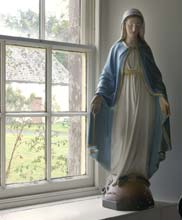History
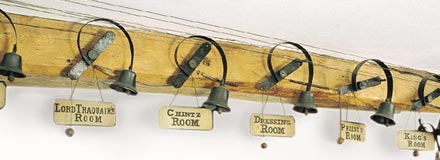
Traquair House
Innerleithen
Scotland
The oldest continually inhabited castle in Scotland
Tour of the House
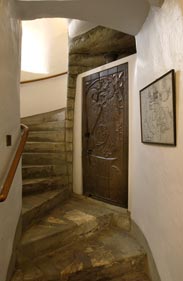
Visitors are able to take a tour through rooms each of which adds an individual quality to the atmosphere of continuity throughout the centuries.

Everywhere are portraits, old prints and maps which refer to the history of the house.
The entrance leads on to the main stone spiral staircase (right) which goes up to the High Drawing Room, bedrooms, Library and Museum.
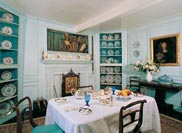
The ground floor gives access to vaulted cellars (above left) and the Still Room (left) which has a fine collection of blue and white china.
If you are staying for bed and breakfast, the Still Room is where breakfast is served.
The High Drawing Room
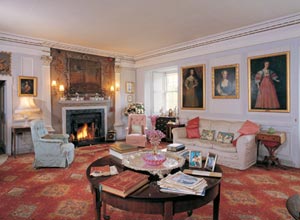
The High Drawing Room.
When completed in the 16th century, the High Drawing Room ceiling was decorated with painted beams and panels: typical of Scottish painted ceilings at that time. The fragments which you can see today were discovered and restored in 1954.
In the middle of the 1700's the fifth Earl of Traquair who had visited Italy as a young man, covered the beams and paneled the walls in the classical style which remains today.

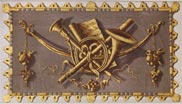
Above the doors he had cartouches painted which symbolise Drama, Music, Painting and Architecture (left)).
There are full length portraits painted in Scotland in the 1630's, a portrait of John Dryden the poet, and the Drawing Room also contains a rare harpsichord (right), in full working order, made by Andreas Ruckers of Antwerp in 1651.
The Kings Room

The State Bed.
The Kings Room and dressing room next door formed the first floor of part of the original 12th century castle.
In 1566 Mary Queen of Scots visited Sir John Stuart, who was 4th laird of Traquair and captain of her bodyguard, with her husband Lord Darnley and infant son James (later King James VI) whose wooden cradle you can see at the end of the bed.
The state bed, which is 16th century, was brought from Terregles House where it was used by Mary when she stayed there.
Museum
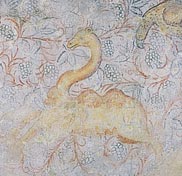
16th century wall painting.
The Museum is a room on an upper floor which probably dates from the 14th century.
It has a fascinating collection of old letters, illuminated books, glass and objects used by the family over the years, and very rare wall paintings from circa 1530 (right).
- Mary Queen of Scots' Rosary and Crucifix.
- An early wood and paper calculator: Napier's Bones.
- A letter signed by Mary Queen of Scots.
- Embroidery from the 1600s.
- Early printed book from 1493, Nuremburg Chronicle.
- Illuminated books.
- Jacobean Glass.
The Library
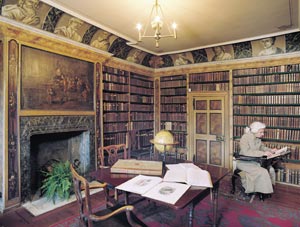
The Library.

Created between 1700 and 1740, the Library has a collection of about 3000 books and has remained almost intact since it was first formed.
Portraits of philosophers and poets around the ceiling cornice are used for cataloging the books, which are numbered and ordered below them.
Over the fireplace is a schoolroom scene, possibly after a painting by Jan Steen and painted by a local artist.


Other Rooms
There are other rooms to see, including a secret passage and Priest's Room where, until the Catholic Emancipation Act of 1829, the resident chaplain lived in hiding.
Downstairs in one of the "modern" wings - which was added to the house in the late 1600's - is the Dining Room and another Drawing Room (illustrated below).
Two of the bed and breakfast guest suites are here too (the other is next to the High Drawing Room).


Traquair is open to the public at certain times of the year. For exact times see www.traquair.co.uk

